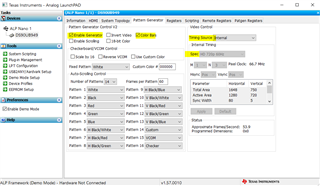Other Parts Discussed in Thread: ALP
Tool/software:
Dear TI,
I am working with the DS90UB949A connected to a DS90UB948, which in turn is connected to an LCD display.
The DS90UB949A and DS90UB948 are on separate boards, linked by a cable transmitting LVDS signals and power. We've observed that after powering on the DS90UB948 (with the LCD attached), the LCD automatically scrolls through white, red, green, and other color patterns repeatedly.
We have not yet configured the DS90UB948. Even when we disconnect the LVDS cable, the issue persists. We attempted to modify registers 0x64 and 0x65 of the DS90UB948 via the I2C interface of the DS90UB949A. Although the register values changed, the output to the LCD did not.
I noticed that controlling the pattern generator (PATGEN) via the serializer is not supported (as mentioned in the document SNLA132G). I2C is not utilized in the local configuration of the DS90UB948 on our board. How can we resolve this issue if the local I2C of the DS90UB948 is not an option for us?



